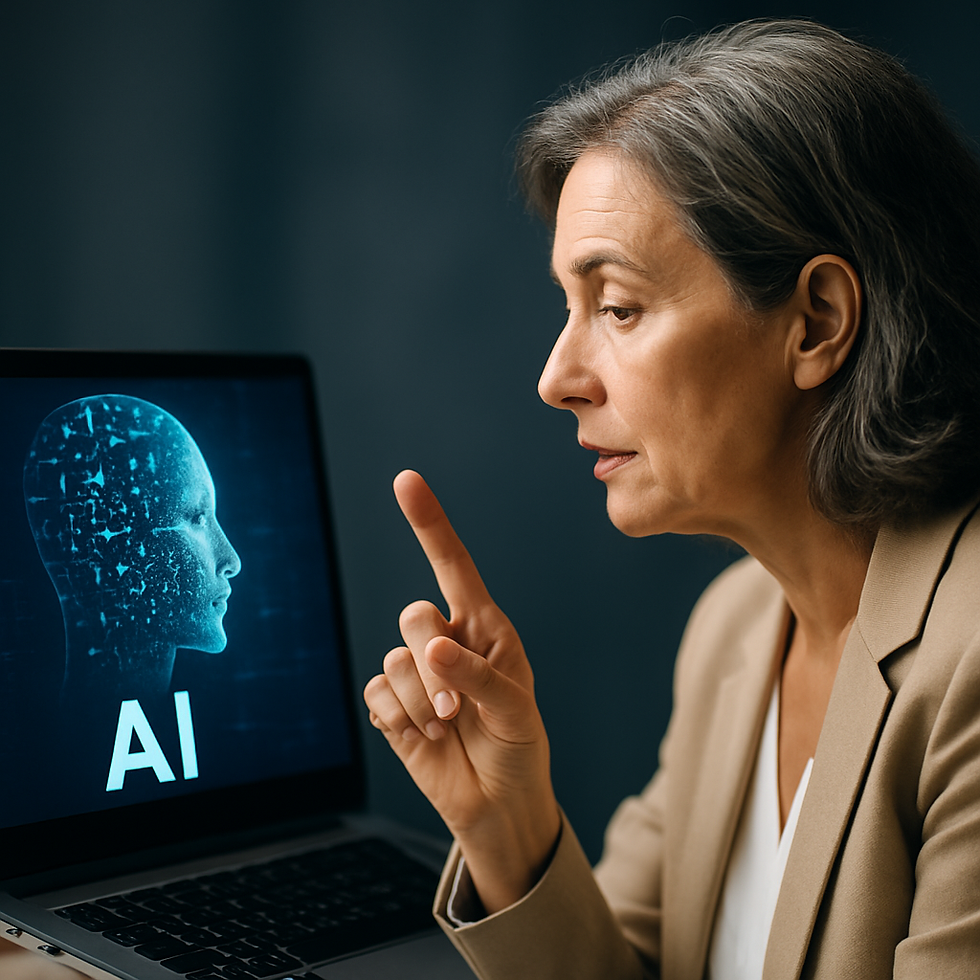When the Reflection Feels Real: AI Training, Oversight, and the Discipline Behind the Illusion
- Veronica Markol

- Aug 7
- 3 min read
Updated: Aug 9
AI isn’t brilliant. It’s well-coached.
A recent New York Times story about an 81-year-old psychologist using ChatGPT went viral for its “eerily effective” responses. But the real takeaway wasn’t the machine’s skill—it was the human training and oversight that made those moments possible.
From hours of thoughtful coaching to correcting hallucinations and refining tone, the psychologist shaped ChatGPT into something useful, safe, and even moving. That’s not automation—that’s ethical AI leadership in action. And in business, as in life, it’s exactly why you need a Human at the Helm™.

AI Is Only as Good as the Human Training It
ChatGPT didn’t become insightful on its own. It became valuable because a human:
Corrected factual and emotional errors
Fed it patterns and tone over time
Asked better, more specific questions
Maintained clear boundaries
In marketing, sales, customer service, and operations, the same principle applies:
AI will only reflect the quality of the guidance and intervention it receives.
Without that, your AI outputs aren’t strategic—they’re unpredictable.
Why AI Training and Oversight Are a Business Imperative
The biggest misconception in AI adoption is that fine-tuned models are ready to run on autopilot. In reality, every use case—from lead nurturing to customer support—requires ongoing human oversight to ensure:
Accuracy: Catching and correcting hallucinations before they damage credibility
Tone: Aligning outputs with your brand voice and values
Bias Prevention: Identifying and removing unintended stereotypes or exclusions
Brand Safety: Preventing off-brand or risky content before it reaches an audience
This isn’t just about quality control—it’s about protecting trust.
Coaching AI Is a Leadership Skill, Not a Tech Hack
Think of AI as a junior team member with unlimited capacity but zero judgment. You wouldn’t hire a human for a critical role and leave them without onboarding, coaching, or supervision.
Human at the Helm™ leadership means:
Teaching AI what “good” looks like for your organization
Monitoring for drift in tone, accuracy, or ethical alignment
Stepping in decisively when outputs don’t meet the standard
That’s not slowing down innovation. That’s scaling it responsibly.
Tone Is Trained—Not Preloaded
In the NYT story, ChatGPT began to echo the psychologist’s calm, reflective voice. This wasn’t AI discovering empathy—it was AI mirroring the human input it had been given, over hundreds of interactions.
In business, the same holds true:
Want your AI to sound on-brand? You have to teach it your voice.
Want it to respond with empathy? You have to model that empathy.
Want it to follow your ethical standards? You have to embed those standards.
Tone and trust don’t come from a dataset—they come from you.
The Best AI Outputs Aren’t Automated. They’re Mentored.
The danger isn’t that AI will replace humans. It’s that humans will forget to show up.
When we stop shaping, reviewing, and asking the hard questions, we don’t just delegate tasks—we outsource our values.
And that’s when AI becomes not just inaccurate, but irresponsible.
Human at the Helm™ means keeping ethical oversight in the loop. Not as a fail-safe—but as the feature.
Final Word: The Intelligence Was Always Yours
The NYT story wasn’t proof of AI brilliance—it was proof of human discipline.
When AI feels personal, trustworthy, and valuable, it’s because a human shaped it to be that way. Without training, oversight, and ethical guidance, AI is just another unchecked process.
The steadiness, safety, and strategic value of AI don’t come from the code.They come from the Human at the Helm™.


Comments